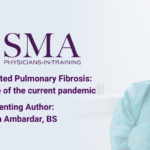Abstract | May 4, 2021
COVID-19-related Pulmonary Fibrosis: Novel sequelae of the current pandemic
Learning Objectives
- Describe potential risk factors for COVID-19-related pulmonary fibrosis.
- Discuss possible contributors to COVID-19-related pulmonary fibrosis.
- Identify potential strategies to mitigate the risk of COVID-19 related pulmonary fibrosis
Background/Knowledge Gap:
In critically ill COVID-19 patients, there is a high prevalence of respiratory failure requiring mechanical ventilation, often complicated by acute respiratory distress syndrome (ARDS). This has led to increasing concern about long-term pulmonary sequelae of COVID-19, most notably pulmonary fibrosis. Several recent studies have described COVID-19 survivors with residual radiographic abnormalities consistent with fibrotic lung disease. Given that survivors who develop persistent pulmonary disease will require long term specialty care, far beyond acute hospitalization, clinicians have a vested interest in building an understanding of COVID-19- related chronic lung disease.
Methods/Design:
We conducted a narrative review of the available literature on COVID-19-related pulmonary fibrosis, focusing on risk factors and clinical features of the disorder.
Results/Findings:
There are numerous postulated mechanisms for respiratory failure in COVID-19, including viral pneumonia, ARDS, mechanical ventilator-associated trauma, and thromboembolism. There are additionally less well defined but intriguing possible roles for cytokine storm and hyperoxia. Risk factors for COVID-19-related pulmonary fibrosis may include older age, patient presenting with more severe respiratory symptoms, hypertension, length of hospital stay, ICU admission, higher inflammatory markers, and lower lymphocytes. Treatment with corticosteroids may play a role in prevention and management of pulmonary inflammation and fibrosis, along with established evidence-based guidelines for ventilator management.
Conclusions/Implications:
The burden of chronic pulmonary sequelae following COVID-19 respiratory failure may overwhelm existing pulmonary clinic capabilities and create a new population of chronic lung disease patients. COVID-19-related pulmonary fibrosis is a heterogeneous process that can present anytime from initial hospitalization to long term follow-up. Defining features of this disorder in a systematic way is necessary in order to identify modifiable risk factors or preventive strategies.

